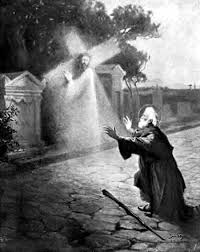[Greek] σταυρόω (stauroō), [Latin] crucifigere: to crucify, to fence with stakes, to impale on the cross, to extinguish; 47 scriptural references

Crucifixion was the Roman Empire’s official means of punishment
Background Information:
Greek culture: Originally, this term means to put up posts, to protect by a stockade, and to enclose by stakes or posts. This term’s meaning to crucify is rarely found. Essentially, the act of constructing a crucifix or building a fence is generally the same. Stakes are needed first in order to build a fence or crucifix. The Greeks were generally opposed to the practice of crucifixion. They considered this as a barbaric form of execution. It is only later when Alexander the Great carries out this practice from the east to the Mediterranean region.
Thucydides’ The Peloponnesian War 7.25: “But the most awkward part of the stockade was the part out of sight; some of its piles which had been driven in did not appear above the water, so that it was dangerous to sail up, for fear of running the ships upon them, just as upon a reef.”
Polybius’ Histories 1.86.4: states “Hannibal pitched his camp on the side of the town nearest to Carthage. When this was done, they brought the captives taken from the army of Spendius and crucified them in the sight of the enemy.”
Thucydides’ The Peloponnesian War 6.100: “The whole army demolished the counterwork, pulled up the stockcade, and carried away the stakes to their own lines.”
Roman culture: The Romans copied this practice from the Persians. Beginning the 1st century B.C., crucifixion was the official punishment practiced by the Roman Empire. Crucifixion was a very brutal form of punishment for non-Romans, leading to eventual death on the cross by asphyxiation. In addition to wielding great social pressure, crucifixion was an effective method in punishing criminals, slaves, foreigners, and traitorous soldiers.
Old Testament: Crucifixion as a form of execution and punishment did not exist in the Old Testament. This form of punishment occurred only when the Roman Empire exerted its influence and control in Jewish society. Traditionally, execution was carried out by means of stoning or being hung from a tree. Examples of hanging on the gallows are found in the book of Esther.
New Testament: Jesus’ crucifixion occurs in the third prediction of the passion by Jesus. Jesus infers His own fate by referring to those others who have been persecuted in the past. In the book of Acts, Peter reproaches the whole people of Israel for crucifying Jesus. Paul speaks of Jesus’ crucifixion in varied and nuanced ways. In one scriptural passage, the follower of Jesus experiences a certain type of crucifixion. Here are some scriptures not directly involving Christ:
Mt.23:34: Jesus states they will crucify some prophets, men, and scribes. (Faithful disciples may experience persecution or martyrdom.)
Mt.27:38: Two revolutionaries were crucified with Him.
1Cor.1:23: The notion of Christ crucified is a stumbling block to Jews and foolishness to Gentiles. (Theological and cultural differences prevent understanding.)
Gal.5:24: Those who now belong to Christ have put to death their for life of passions and desires. (Putting to death evil and sinful desires.)
Gal.6:14: The world has been crucified (made dead) to me. (Paul no longer needs approval from the world.)

Early Christianity:
- The Christian writings about Jesus’ crucifixion were common.
- One such example is the Christian tradition regarding Peter. Peter is fleeing Rome from his likely crucifixion at the hands of Nero.
- An image of the risen Jesus appears to Peter on the road. Peter asks Jesus, ‘Quo vadis?’ meaning ‘Where are you going?’
- Jesus replies, ‘Romam eo iterum crucifigi’ meaning ‘I am going to Rome to be crucified again.”
- Upon hearing this Peter thereby gains the courage to return to his ministry in Rome.
- Eventually, Peter is martyred by being crucified upside down.
The Church of Domine Quo Vadis in Rome:
- This church is built at the location where the meeting between Peter and Jesus took place.
- The Polish writer Henryk Sienkiewciz later wrote Quo Vadis: A Narrative of the Time of Nero.
- The film Quo Vadis was later made in 1951.
Conclusion:
Crucifix, crucifixion
In the Greek era, it was interesting to discover that this term originally meant to put up a post or fence. Perhaps it is not surprising that the Greeks perceived that crucifixion was a cruel form of execution. I did not realize that Alexander the Great carried out this practice of punishment. In the Roman era, crucifixion was a punishment given to Jews and slaves. Likewise, Paul, as a Roman citizen, was afforded the ‘dignity’ of being killed by decapitation.
The Jews accused Jesus of the high crime of blasphemy. This later leads to Jesus’ crucifixion. As a sacrificial offering, Jesus takes upon Himself the sins of humanity. Yet, Jesus’ death on the cross brings about a greater good and redemption for all.
It is interesting to note that the Greek meaning for stumbling block, trap, and snare is skandalon (scandal). It is no surprise that this is where we stumble, get stuck, or get trapped.
This term is only used in a singular sense for one person. Interestingly, the word crucifixion does not appear in the bible. Instead, this idea is expressed as the “cross of Christ” or “Christ was crucified.” Jesus is the Bridegroom. The Church is His bride. By dying on the cross, He consummates His marriage to His bride.
Update: In a sense, Bishop Strickland has been metaphorically crucified in the court of public opinion for not towing the Modernist line. Some may perceive him as a “white martyr” in being removed from his office.
It seems that clergy must have courage in speaking out against Pope Francis. Many are fearful and afraid of being expelled, cancelled, and laicized by the Vatican.
Traditional (conservative) clergy and laity are constantly criticized, impugned, and accused of being “rigid” in their beliefs.
Many of the Catholic faithful are being marginalized as Traditiones Custodes continues to clamp down on the Traditional Latin Mass.
Modernists often face a stumbling in understanding that the Traditional Latin Mass has existed throughout the long-term existence of Jesus’ Church.
It goes without saying there is a lot at stake (our redemption) about what happens on Good Friday!
